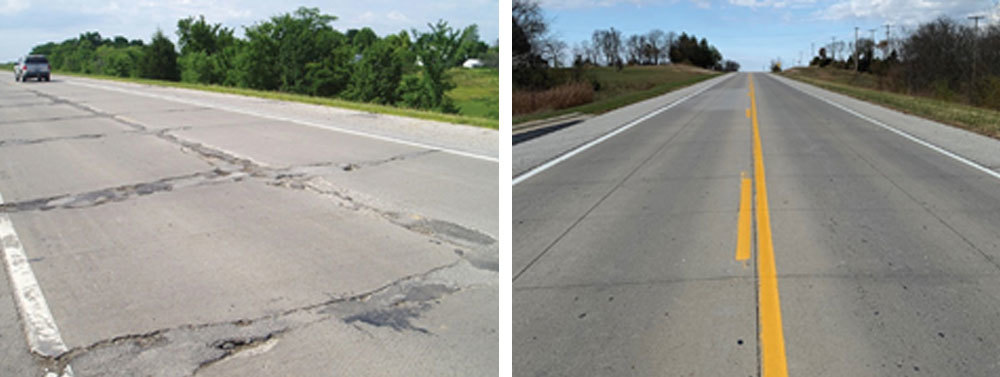TOPS News:
July 2022 |
|
 |
The Popularity of Concrete Overlays Grows
The volume of concrete used for pavement overlays has tripled since 2005, increasing from about 4 percent to 12 percent annually in America.
There are two categories of concrete overlays: bonded or unbonded. Either can be placed over concrete, asphalt, or composite pavements. The Missouri Department of Transportation (MoDOT) commonly constructs three types of concrete overlays to restore or increase structural capacity, including:
- Unbonded overlays are typically 8 inches thick with 15-feet long by 12-feet-wide panels placed over an asphalt or geotextile interlayer.
- Big block overlays or unbonded overlays are typically 5 inches thick with 6-foot by 6-foot panels placed either without an interlayer or over an asphalt or geotextile interlayer.
- Bonded overlays on asphalt are typically 4 feet by 4 feet and 4 inches thick and used to add structural capacity to an existing pavement in fair or better condition.
MoDOT chose to use a big block concrete overlay in 2008 to address nearly 4 miles of a Missouri secondary State route that was severely distressed with spalling and durability or freeze-thaw cracking. The segment was originally constructed in 1986 with 8 inches of jointed reinforced concrete pavement. MoDOT installed an asphalt interlayer prior to placement of the new concrete overlay. The interlayer provides a shear plane to reduce stresses in the existing pavement from reflecting through the new concrete surface.
 The condition of Missouri Route D in 2007 before overlay construction (left) and the unbonded concrete overlay in 2020 after 12 years in service (right). (Source: Todd LaTorella, MO/KS Chapter of the American Concrete Pavement Association)
As of 2020, only minor repairs have been required, including minor full-depth patching at the transition areas on either end of the overlay. Fewer than one percent of the overlay slabs are cracked.
TOPS Resources
Looking for more information? Visit the FHWA Targeted Overlay Pavement Solutions (TOPS) website for a variety of resources including case studies, one-pagers, and webinars. Contact TOPS co-team lead, Robert Conway (concrete), or Tim Aschenbrener (asphalt).
Check out a TOPS Webinar
The TOPS team has hosted three webinars in recent months including:
Stone Matrix Asphalt and Highly Modified Asphalt Webinar
Learn about SMA and HiMA and hear presentations from Georgia and Florida.
High-Performance Thin Overlays and Crack Attenuating Mixture Webinar
Learn about HPTO and CAM and hear presentations from New Jersey and Texas.
An Overview of Concrete Overlays Webinar
Get an introduction to concrete overlays, understand the challenges and value proposition, learn how to get started, and more.
Stay Connected |
|
 |
If you are not already a subscriber, the Center for Accelerating Innovation invites you to subscribe to EDC News and Innovator. These newsletters showcase successful deployments of EDC initiatives and other innovative topics in the highway industry.

|